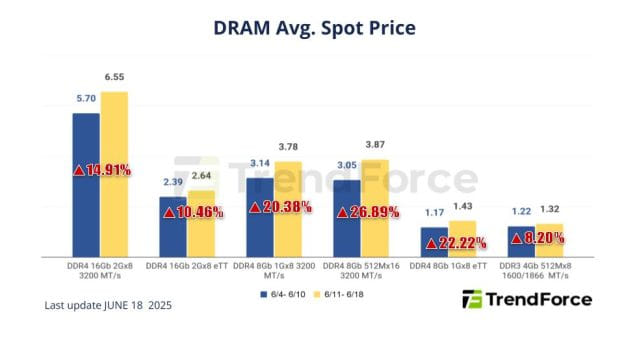The dynamic landscape of the memory market has recently seen notable shifts, particularly regarding DRAM and NAND flash products. Market leaders SK hynix and Micron are currently engaged in last-time buy negotiations for DDR4 memory chips, driving spot prices higher in anticipation of contract price hikes expected in the third quarter of 2025. These developments suggest a tightening supply situation, influencing both manufacturers and consumers alike.
Current Trends in DRAM Prices
DRAM memory, especially DDR4, has been at the forefront of price increases. According to a recent report from TrendForce Corp, DDR4 products are experiencing the most significant price hikes in the spot market. Notably, modules are surpassing individual chip prices, which indicates a continued demand for DDR4 support among older platforms and device models still prevalent in the market. The average spot price for mainstream DDR4 chips, specifically the DDR4 1Gx8 3,200MT/s type, has surged by 22.2% week-over-week, climbing from $3.421 to $4.182.
The reason behind these increasing prices is tied to the active negotiations between SK hynix, Micron, and DDR4 customers. As both companies prepare to phase out production of DDR4, customers are attempting to secure their final orders before prices escalate further. As a result, the market is bracing for even higher contract prices, projected to impact the market significantly in Q3 2025. This strategic decision from manufacturers reflects a broader trend within the semiconductor industry, which is moving towards newer memory technologies such as DDR5.
Market Conditions for NAND Flash
In contrast to the soaring prices of DRAM, NAND flash memory is currently experiencing a more subdued market environment. Despite lingering concerns over the global semiconductor supply chain, particularly in connection with China’s stringent policies on imported memory products, the NAND flash wafer market is characterized by sluggishness. Most prices are remaining stable, with a slight decline observed this week; for instance, the price of 512Gb TLC wafers dropped by 0.52% to $2.693.
Rumors surrounding China’s crackdown on the smuggling of foreign memory products have dampened market sentiment, leading buyers to adopt a more conservative approach. The anticipated tightening of supply chains and ongoing geopolitical tensions have made many participants hesitant to stock up significantly. As a result, trading activity remains limited. Suppliers and consumers alike are in a cautious stance, awaiting clearer signals regarding future supply dynamics.
Market Implications and Future Outlook
The current trends in both DRAM and NAND flash sectors highlight the complexity of the memory market and its interconnectedness with global events. The upcoming price adjustments for DDR4 may result in a rush for last-time buys, heavily influencing inventory strategies among manufacturers and consumers. In contrast, the NAND market’s tepid activity reflects a broader strategic reevaluation among buyers, suggesting that market players may opt for a wait-and-see approach in the near term.
Understanding these market dynamics is essential for stakeholders looking to navigate the evolving landscape effectively. The anticipated rise in contract prices for DDR4 could lead to increased costs for end consumers and impact sectors reliant on this older technology. Conversely, the limp performance of NAND flash underscores the need for buyers to stay informed about policy changes and market conditions. Analysts and industry experts will continue to closely monitor these developments as they unfold, particularly with the ongoing implications for tech manufacturers and consumers alike.
Quick Reference Table
| Memory Type | Current Spot Price | Price Change | Anticipated Changes |
|---|---|---|---|
| DDR4 (1Gx8 3,200MT/s) | $4.182 | +22.2% | Contract prices expected to rise in Q3 2025 |
| NAND (512Gb TLC) | $2.693 | -0.52% | Stable with limited demand |
In conclusion, the memory market is in a state of flux, with significant changes anticipated in both DRAM and NAND sectors. Stakeholders must stay vigilant and informed as these trends evolve, shaping the future of technology and its associated costs.

